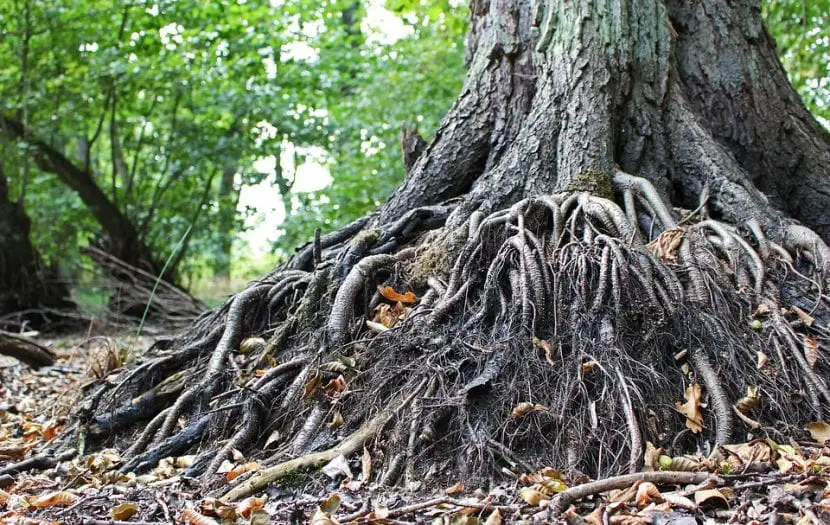

The root system of plants is the most important part of their body: if they did not have roots, they would not be able to anchor themselves to the ground, nor absorb the nutrients from it, and therefore could not grow to several tens of meters as do, for example sequoya.
When choosing them to plant in the garden, it is necessary to know what types of roots they havesince knowing this will help us to locate them in the most appropriate place.
What is it and what are the functions of the root?


The root is an organ that does not have leaves, and that generally grows below ground level, although there are exceptions as we will see later. Its functions are to anchor the plant to the ground so that it is not blown away by the wind, absorb water and nutrients dissolved in it of the earth, and accumulate reserve substances to survive in unfavorable seasons (extreme drought, very harsh winters, …).
What is the structure of the root of a plant?


Image – slideplayer
The structure of the root can surprise us a lot. From the outside, we only see very fine stems, usually dirty white, that penetrate the soil as they seek moisture and absorb the nutrients dissolved in said water. But If we cut a piece, and then we make a cross section, if we observe it through the microscope we will immediately see that it is made up of different parts.
From the outermost part inwards, we have:
- epidermis: it is a protective barrier with absorbent hairs that what it does is try to prevent the microorganisms that live in the soil from infecting the plants. The hairs detect moisture, and absorb it.
- Cortex: it is made up of one or more layers of cells (depending on whether the root grows below ground level or is aerial). It serves as storage of reserve substances, and also as a way through which the water and salts absorbed from the soil will pass to the conductive tissues, which are responsible for distributing them throughout the rest of the plant.
- Vascular cylinder: which is separated from the cortex by a layer of cells.
- endodermis: it is a layer of cells that are arranged in a compact way that are in the innermost part of the cortex.
- Phloem: it is in charge of transporting nutrients.
- Xylem: is responsible for transporting liquids.
- danger: it is a layer of parenchymal cells that give rise to secondary roots. It is not always present, since some aquatic and parasitic plants may not have it.


Related article:
Parts of the root of a plant
What types of roots are there?
According to their shape, they are distinguished from several types:
- Axonomorphic, pivoting or typical: a main root is distinguished, which is the one with the greatest thickness, and other finer ones.
- Examples of plants: trees and shrubs.
- Atypical, fibrous, or fasciculate: all the roots are more or less equal, and arise from the same point.
- Examples of plants: herbaceous flowers (petunias, geraniums, marigolds, etc.), palms.
- Napiform: it is formed by a thick main root, which accumulates reserve substances.
- Examples of plants: carrots, turnips, etc.
- Branched: they look a lot like the structure of the branches of a tree. There is a main or taproot that is thicker than the rest.
- Tuberous: its structure is fasciculate. When they accumulate reserve substances, they widen.
- Examples of plants: potatoes, beets, sweet potatoes, clivia, cassava, etc.
And according to your address, the following:


- Adventitious: are those that grow above ground level. They are used by plants to expand, such as the corn, ivy, or common grass. Learn More.
- Aquatic: they are those that grow in water, usually sweet like that of lakes, streams or rivers, but it can also be salty, like that of mangroves.
- Climbers: these types of roots grow by attaching themselves to the trunks and branches of other plants.
They are not parasites, in the sense that they absorb the nutrients from the soil, but it can be the case that the plants grow so much that little by little they prevent the plants that serve as support from being left without the possibility of capturing sunlight and die.
Some examples are the wisteria, bougainvillea or clematis. Learn More. - Parasites: these roots do do everything possible to prevent the plants that support them from feeding. Often the seed germinates on a branch, or in a hole in the trunk, and from there the roots grow in such a way that they can strangle the trunk. A clear example is the strangler fig, whose scientific name is ficus benghalensis.
What are the types of edible roots?


Roots are essential for plants, but why fool ourselves? They are also very interesting for us humans. There are many that are edible, such as the radish, licorice, beet, potato, carrot, ginger o turmeric. In the links you will find all the information about the cultivation of each of them.
What did you think of this topic?

3 thoughts on “What types of roots do plants have?”